#la chapelle royale
Explore tagged Tumblr posts
Video
The Royal Chapel - Palace of Versailles, France by John Wolfe Via Flickr: La Chapelle Royale, Château de Versailles, France
#Palace of Versailles#Château de Versailles#La Chapelle Royale#Royal Chapel#Chapel#Church#alter#France#Place#d'Armes#Place d'Armes#Louis XIII#Ancie Regime#Louis XIV#18th Century#Architecture#Jules#Hardouin-Mansart#worship#Palace#Versailles#Vertorama#columns#French#Baroque#art#organ#gold#marble#flickr
17 notes
·
View notes
Text

The Royal Chapel of Versailles
#the royal chapel#la chapelle royale#la capilla real#palace of versailles#versailles palace#palais de versailles#versailles#france#francia#europe#europa
25 notes
·
View notes
Text
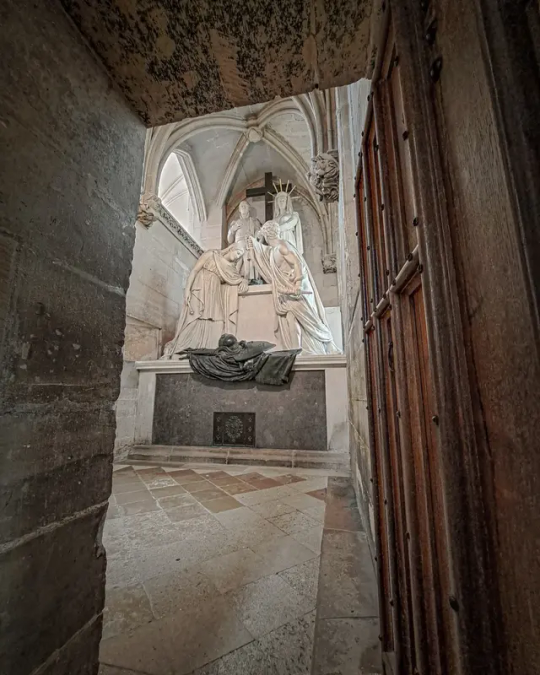

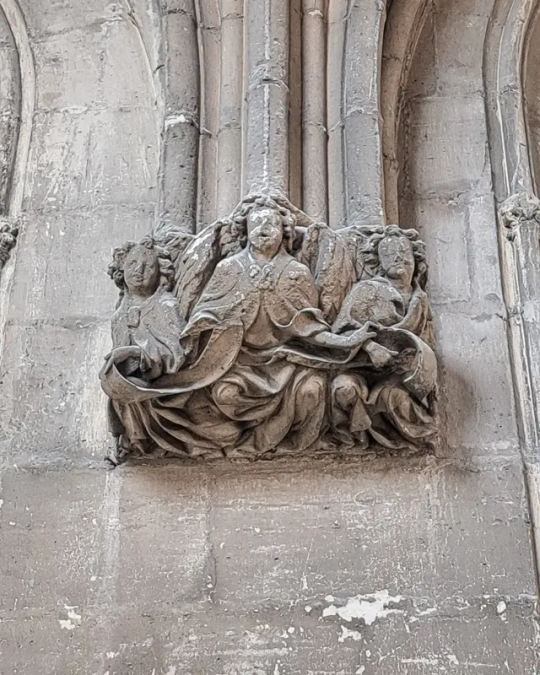
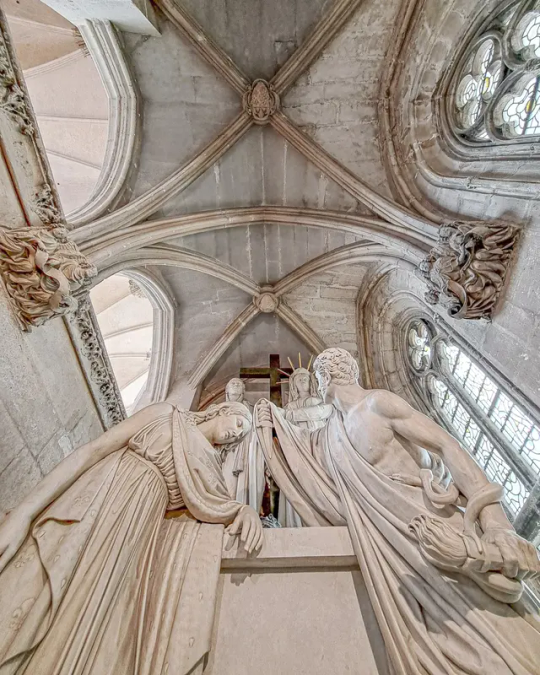
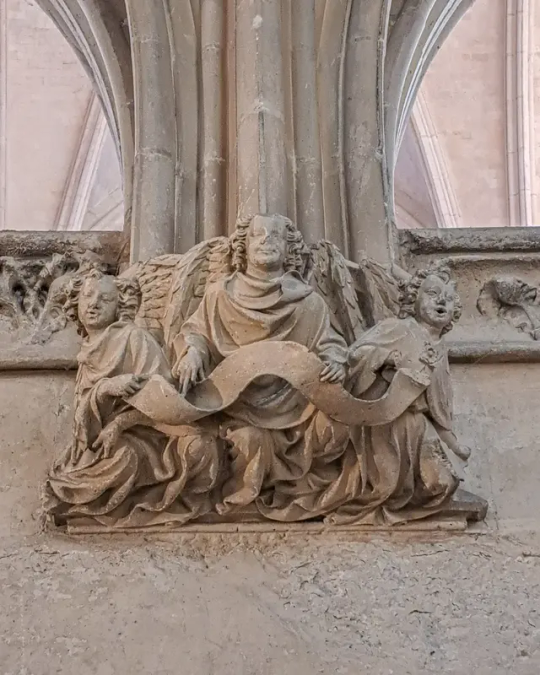
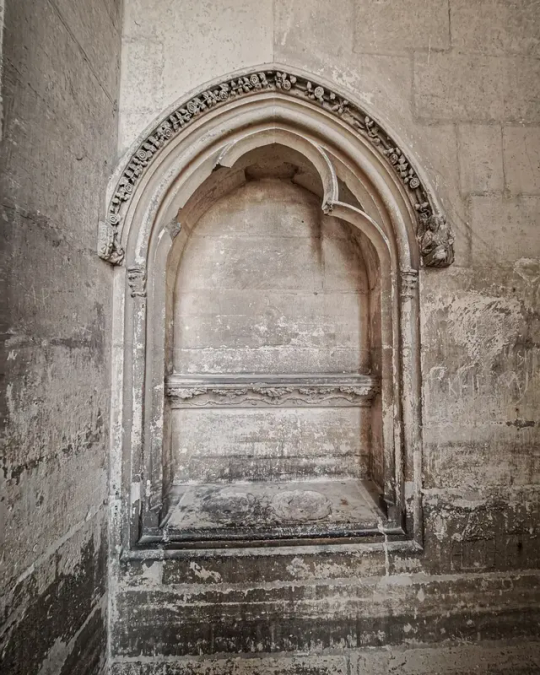
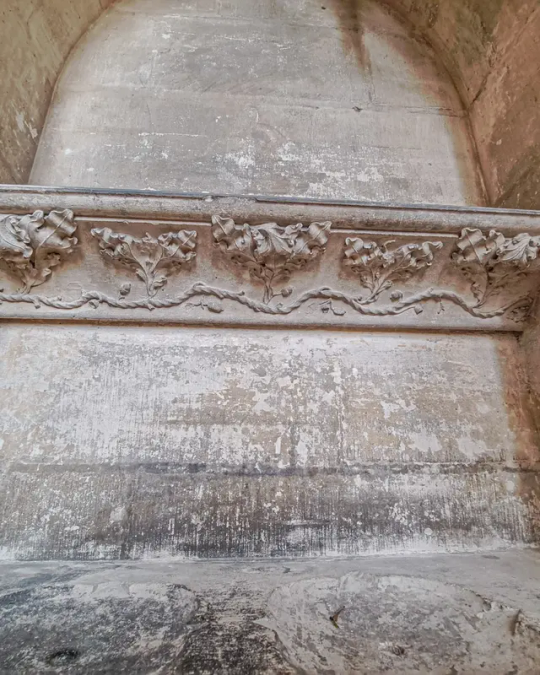
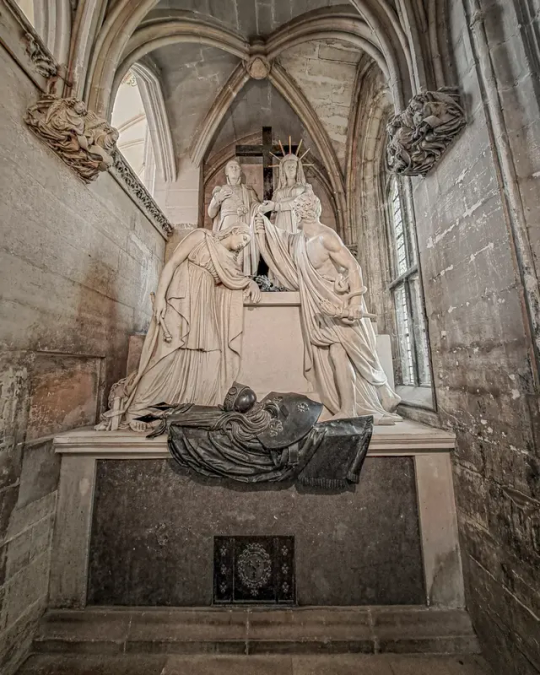
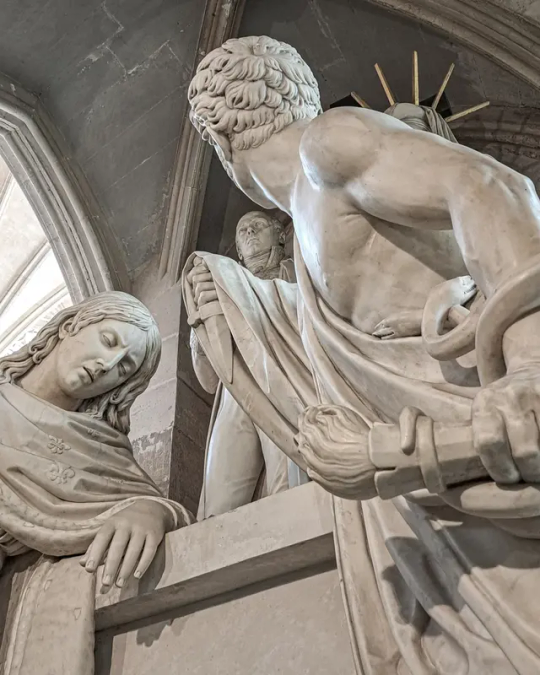
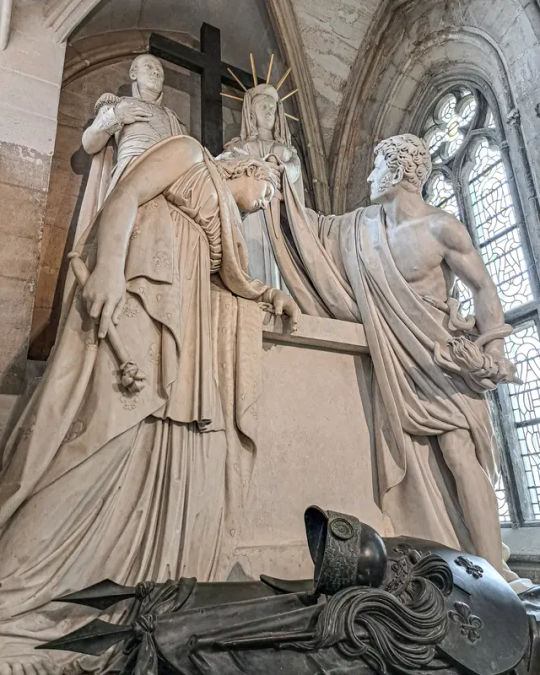
The Sainte-Chapelle de Vincennes is a Gothic royal chapel within the fortifications of the Château de Vincennes on the east edge of Paris, France. It was inspired by the Sainte-Chapelle, the royal chapel within the Palais de la Cité in Paris. It was begun in 1379 by Charles V of France to house relics of the Passion of Christ. It is no longer used as a church, and is now a French historical monument operated by the Centre des monuments nationaux.
Here on display the side chapel with the tombe of the Duc d'Enghien who was executed in 1804. (He was charged , innocently it seemed afterwards, to be involved complotting against First Consul Napoleon Bonaparte.) The sculpture is made by Pierre Louis Deseine in 1824.
#vincennes#chateaudevincennes#europe#architecture#historic buildings#architectural history#history#art history#historical#france#paris#sculptor#sculpture#scultura#tombeau#tombstone#tomb#tombe#neoclassico#neoclassicism#neoclassical#gothic#memorial#chapel#chapelle#funerary art#artwork#art#arte#explore
608 notes
·
View notes
Text
Next on the list of Snow White tales in the book Sleeping Beauties: Sleeping Beauty and Snow White Tales From Around the World are the versions from France and Italy.
*The first of the three French tales is The Lay of Eliduc, composed by a medieval woman poet, Marie of France. It's not really a Snow White story, but it does feature a beautiful princess in a deathlike trance. A knight, Eliduc, is unjustly banished by his king, and forced to travel to another kingdom, where he helps the local king to win a war. During this time, he falls in love with the king's daughter, Guillardun, and she with him... but unfortunately, he already has a good, faithful wife, Guildeluec, back in his homeland, and is torn between his new love and old love. When Guillardun learns that Eliduc is already married, she falls into a swoon from which nothing can revive her. Distraught, Eliduc lays her to rest in a chapel in the woods, which he frequently visits from then on, even after he goes back to his wife. Guildeluec sets out to learn the cause of her husband's mysterious sadness, and discovers the chapel and Guillardun lying inside it. Then, in a detail that evokes the Grimms' tale of The Three Snake Leaves, she sees a weasel use a certain flower to bring its dead mate back to life – she uses the flower to bring Guillardun back to life too. After the whole story is revealed, Guildeluec graciously leaves her husband and becomes a nun, allowing Eliduc and Guillardun to marry.
**Besides the tale itself, the book includes an essay which highlights the parallels between this story and the Celtic Snow White tale of Gold-Tree and Silver-Tree, which will be overviewed later. The author suggests that Marie of France may have heard a variant of Gold-Tree and Silver-Tree and drawn inspiration from it.
*The book also includes two other French Snow White tales: The Mirror and The Stepmother.
**The Mirror is nearly identical to the Grimms' Snow White (a wicked queen stepmother, a magic mirror, a poisoned apple, etc.) with two chief exceptions. (1) Instead of seven dwarfs in a cottage, the heroine, Blanche, comes to live with seven giants in a castle. (2) The details of the ending. Some time after Blanche's "death," a royal wedding is held in another kingdom, and the seven giants are invited. Rather than leave Blanche's glass coffin unprotected, they carry it with them, but on their way they accidentally drop and shatter it, jarring the piece of apple from Blanche's mouth and reviving her. She then goes with the giants to the wedding, where, as it happens, her father and stepmother are guests too. Blanche reunites with her father and accepts the marriage proposal of a prince who also attends, while the queen is forced to dance to death in hot iron shoes.
**In The Stepmother, the heroine isn't a princess, but an innkeeper's daughter, and her jealous stepmother convinces her weak-willed father to abandon her, a la Hansel and Gretel. She meets a band of thieves who take her in. But sometime later, she shows kindness to an old beggar woman, who is really a wicked witch, and who offers to comb her hair, only to stick a magic pin into her head that freezes her in place like a statue. (Strangely, there's no mention of any connection between this witch and the stepmother.) The heartbroken thieves keep the "statue" on display in their house, until one day a prince discovers her, falls in love, and takes her back to his castle, where he secretly keeps her in his room. But one day the prince's sister discovers the "statue," tries to comb its beautiful hair, and takes out the pin, bringing the heroine back to life. The prince and the heroine are joyfully wed and have twins. But soon the prince is forced to go to war; while he's away, the wicked stepmother forges a letter from him and sends it to the castle, demanding that his wife and children be banished. But in the woods with her children, the heroine prays, and miraculously a house springs up for the three of them to live in, until in the end the prince finds them.
*I've also read another French variant, La petite Toute-Belle, which isn't included in this book. In that tale, the heroine is pushed down a well (evoking Mother Holle) by her wicked mother's servant, lands in the home of three friendly dragons, is later poisoned with a dress, then set afloat on the sea in her coffin, and washes up near the castle of a young king, whose mother takes off the dress and revives her. Why Heiner left it out of her collection I don't know.
Next come a long list of variations from Italy.
*The first is The Young Slave from Giambattista Basile's Il Pentamerone, which is often labeled a Snow White story, though it's really more of a cross between Snow White, Sleeping Beauty, Cinderella, and The Goose Girl. A group of young maidens, including a baron's sister, have a contest to see who can jump over a rosebush without damaging the single rose on it. The baron's sister knocks off just one rose petal, but she secretly swallows it so no one will know. As a result, she gives birth to a baby girl, whom she names Lisa, and whose birth she keeps a secret from everyone except the fairies because there's no father. As in Sleeping Beauty, the fairies each give Lisa a blessing, but one fairy twists her ankle while running to the cradle, and in her pain she curses Lisa to die at age seven when her mother accidentally leaves a comb stuck in her hair. Sure enough, seven years later, it happens. Rather than bury Lisa, the distraught mother places her in the innermost of seven crystal chests, which she hides in a secret room in her brother's castle. She then falls ill with grief and dies, on her deathbed warning her brother never to look inside that room. Some time later, the baron marries, and warns his wife never to look in the secret room either. But of course, out of curiosity, she does, and she finds the dead Lisa grown into a beautiful maiden. In a jealous rage she grabs Lisa's hair, and in doing so she dislodges the comb and revives her. Then she dresses her in rags, forces her to work as a slave, and constantly abuses her. But eventually, the baron goes on a journey and asks all the castle servants for gift requests, including Lisa, whom he doesn't know is his niece. Lisa asks for a doll, and when she gets it, she tells her troubles to it every day. Finally, the baron overhears her and learns her true identity. The cruel wife is sent away, and the baron becomes Lisa's guardian and eventually finds a good husband for her.
*As for the other Italian versions, there are too many to summarize each one, so I'll just overview the details:
**The heroine is typically a commoner, not a princess. As in The Stepmother from France, her wicked mother or stepmother is sometimes an innkeeper, who learns of the heroine's survival from travelers to the inn who saw her.
**Only a few of these versions have the villainess be the heroine's own mother. The majority seem to feature a stepmother, and several follow the pattern seen in some Cinderella stories from the same region, where she starts out as the heroine's seemingly-kind teacher, whom the girl persuades her father to marry. In a few versions, however, the heroine is persecuted by two older sisters.
**Some versions include a magic mirror, while others have the heroine's survival and whereabouts reported by a bird, an animal, or a beggar whom she was kind to.
**Two versions introduce the prince at the very beginning, and have him visit the three sisters and be smitten by the youngest while slighting the older two. This takes the place of the mirror proclaiming her the fairest in the land.
**There typically isn't a huntsman figure. The villainess usually just abandons the heroine in the wilds, or has a maidservant do it, or else convinces the girl's father to do it, Hansel and Gretel-style.
**The counterparts of the seven dwarfs vary widely. Sometimes they're fairies, sometimes a band of thieves, in one version an ogre and his wife, and in another just a kindly old man. In two versions, it's a dead lady trapped on earth in her castle as a form of purgatory, whom the heroine cares for until her sins are expiated and she rises to heaven; unfortunately, her ascent happens just before the last attempt on the heroine's life, so she's not there to warn her about the poison the way she was before. In yet another Italian version I've read that isn't included here, Giricoccola, the heroine's helper is the moon, who lifts her out of the attic where her jealous sisters have imprisoned her and carries her away to her heavenly castle.
***In the versions with the thieves, the heroine typically hides in their house for the first few days, eating, drinking, and cleaning the house while they're away, much to their confusion when they come home. But soon they discover her and welcome her into their family.
**The villainous mother, stepmother, or sisters typically don't practice witchcraft themselves in these versions, but consult a witch, who creates the poisoned items for them.
**The poisoned item that finally "kills" the heroine is almost always an article of clothing: e.g. a dress, a hat, a hairpin, or a pair of slippers. In some versions she simply falls down dead or in an enchanted sleep, while in other versions she becomes motionless like a statue, or actually turns to stone. But either way, the prince typically finds her, falls in love, and takes her home to his castle, where he lets no one else inside the room where he keeps her. But then one day a woman – his mother, his sister, or a servant – sneaks in, discovers the girl, and tries to make her look more presentable, removing the poisoned item in doing so. Her revival becomes a joyful surprise for the prince when he comes home.
***Only one version, The Beautiful Anna, has the heroine poisoned by a grape, which the prince later dislodges from her throat by stroking her beautiful neck while admiring her.
***Several versions use poisoned food (usually cake or sweets) for the first one or two murder attempts. But either the heroine is warned not to eat it, or else an animal eats it first and dies. It's an interesting contrast to the familiar Grimms' version, where the queen's first two attempts to kill Snow White with articles of clothing fail because they're easily removed, so she turns to the more seemingly foolproof method of poisoned food for the third try.
**In the versions where the heroine "dies" rather than becoming a statue, she's either placed in a glass, crystal, or jeweled coffin by her companions, or else she just lies where she fell in the castle where she now lives alone, to be found later by the prince when he ventures inside, a la Sleeping Beauty.
*The villainess is sometimes executed by the prince in the end, but in other versions she goes unpunished.
**Two versions, The Beautiful Anna and Maruzzedda, continue after the heroine revives with second halves that recall certain Sleeping Beauty tales. The prince marries the heroine and fathers two or three children with her, but he keeps his marriage and children a secret from his cruel, possessive mother. Eventually, the mother finds out and tries to have the heroine and children killed, but in the end her schemes are thwarted and she's put to death instead.
Coming up next: versions from Greece, Albania, and Turkey.
@ariel-seagull-wings, @adarkrainbow, @themousefromfantasyland
#snow white#fairy tale#variations#sleeping beauties: sleeping beauty and snow white tales from around the world#heidi anne heiner#france#italy
60 notes
·
View notes
Text


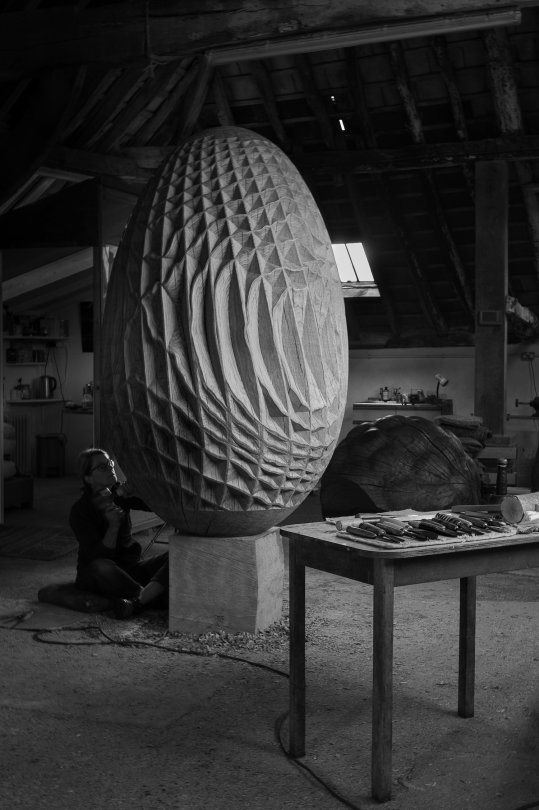
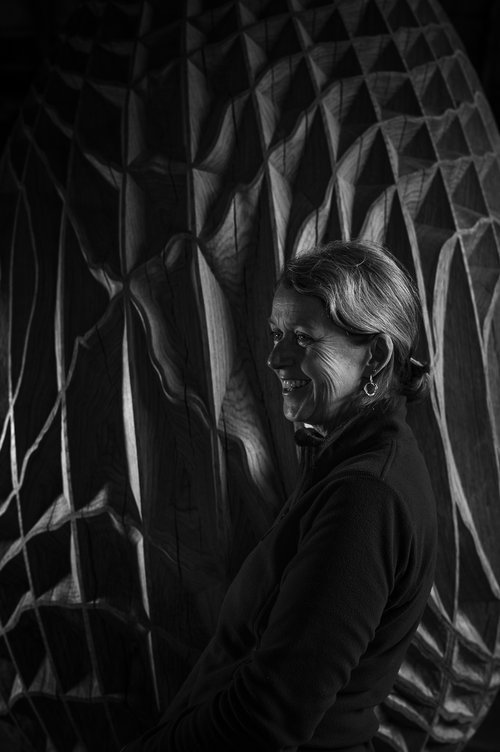



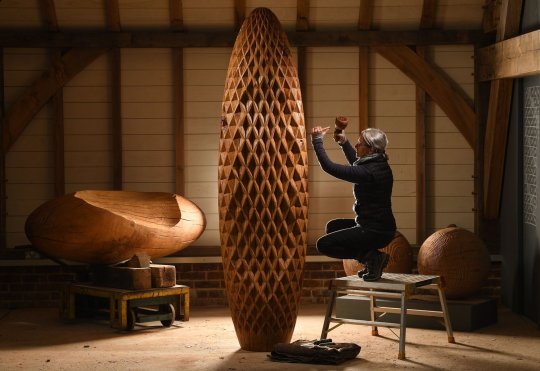


Born in Keighley, West Yorkshire in 1965, Alison Crowther is a sculptor and furniture maker working exclusively with English Oak. Having first studied 3D design at Buckinghamshire College and then Furniture design at the Royal College of Art, her first notable commission were the pews she created for the Prior Silkstede Chapel at Winchester Cathedral (1996) followed by Lover’s Seat at Chatsworth in 1999. Over the last twenty years, she has produced significant, site-specific works for international, corporate clients such as Swire Properties in Hong Kong: the Sheraton Hotel at Ghuangzhou, China; and the Shangri-La Hotel’s iconic Ting restaurant at The Shard in London. She has also undertaken many private commissions throughout Europe and the USA, including Martha’s Vineyard and Nantucket Island.
The way Crowther observes and responds to her material, taking cues from the density, grain and growth pattern creates what Madeleine Bunting described as a ‘dialogue between material and human intervention'. Using tools that range from chainsaws to chisels, she produces work that is sometimes domestic in scale and functional in use, such as Glyndebourne Kissing Benches and sometimes monumental, as with Scale Tree I, created for One Shenzhen Bay. All her work is painstakingly hand-carved from great trunks of unseasoned oak, taken from responsibly managed woodlands within the South Downs National Park. Guided by the natural characteristics of the wood - often embracing the gnarly surface texture - her forms are true to the organic nature of the oak, while also complementing the environments in which they are to be ultimately used and displayed. The wood itself is on a continuous process of change and refinement as the timber ages and weathers, adding to its beauty and character.
80 notes
·
View notes
Text
Red like fire...{Part 1}
(Frollo X Edith X Phoebus)
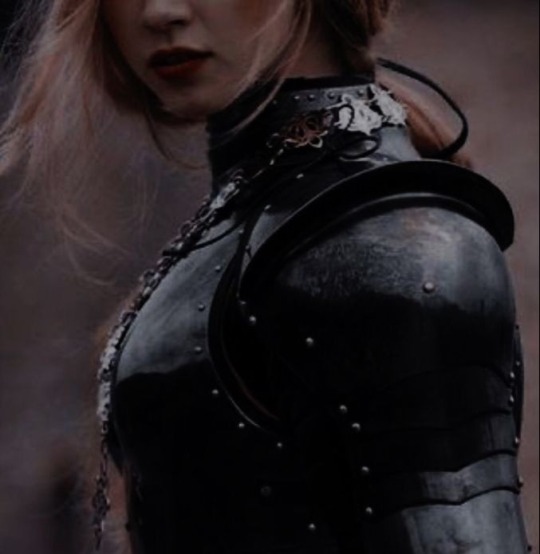

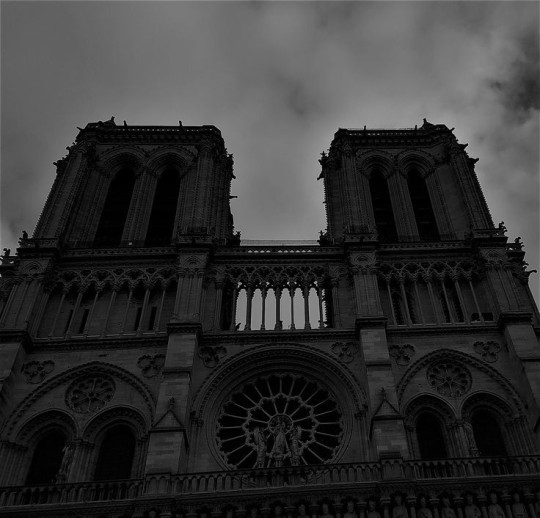
Warnings: Some prejudiced speech, use of the word "Gypsies" (But only in Frollo's speeches since we know what kind of character he is.) Age gap, Frollo being Frollo.
Synopsis: Frollo needed a new captain to help him with the problems with the romani, but he didn't imagine that the captain would be a woman, causing many disagreements between the two of them since the arrival of the captain.
A/N: I swear I thought of this story when I was taking a shower, Lol. I decided to post this while part two of "Undesirable encounter" yet being made. And I was also surprised that there wasn't any Phoebus fic, so I thought I'd do one. This time I won't use "Y/n" I thought it would be better to create a character, but you can imagine yourself in her place and I hope you like her. Enjoy!!
Love and lust. The feelings that show the true nature of man, even man who calls himself "holy" and "righteous". These feelings drive us to commit so many crazy things just for attention, a look or even a touch. Especially when that feeling comes from someone who has repressed it for so long, hiding their true desires and monstrosities for fear of experiencing sin.
Frollo, the judge, needed help dealing with the Romanis who were entering Paris. He suspected that there was some kind of "nest" in which they were hiding and that they were spreading out from this hiding place. To help him with this task, the judge decided to call in a captain of the royal guard who was in a nearby town and who was free of missions at the moment. Luckily, he found someone, but he had no idea that the captain would actually be a woman...
Her name was Edith Chapelle, and she was the first woman to become captain. When she received the letter from the Judge of Paris, she immediately packed her things and rode her gray horse, Hermes, into town. Of course, it wasn't very common in the 15th century for a woman to hold such an important position; she was forced to deal with a lot of nasty comments and nicknames and, of course, being called a 'witch', but she managed to cope very well.
She began her career as a captain when her father, a former captain, was called up for a war, but was ill and had no male son to replace him, so Edith took his place. The impression was horrible at first, but, being clever, she gradually gained the respect of the men and put them in their place.
Unfortunately, only her surname remained on the list, which often confused the men into thinking that the captain was a man because she bore her father's surname. And as soon as she arrived, it was always a break in expectations for everyone, along with some people's thoughts about her. For Edith, it was no different with that judge.
After riding for a long time until she arrived in Paris, she began to pass through the city, a little lost and, of course, receiving looks of strangeness and disgust. Even with that, she could tolerate it. “Is it possible that, in such a big city, no one has ever seen a woman wearing pants and armor?” A small laugh burst from her lips at the thought.
She was looking for the Palace of Justice and tried to look at the map, but the city had changed a lot and the map would be of no use at the moment.
"Come on, it shouldn't be so hard to find," she thought to herself as she led the horse through the city streets and along La Cité, near Notre-Dame. The woman gazed in awe at the great cathedral, it was still as beautiful as the last time she had seen it, and a small smile appeared on her face as she remembered the good times she had had in this city, especially at Notre-Dame. She let her thoughts take her away and suddenly her horse grumbled and tapped its legs impatiently on the ground:
“Calm down, Hermes.” The redhead tried to calm her animal by patting the side of its neck. “I guarantee that when we arrive, you'll have your carrots. We just need some information...”
The woman commented as she looked around and got off her horse, looking for someone to ask for information. It was a bit difficult with the Parisians passing by and ignoring the visitor, if not, they just gave uncomfortable looks or the mothers whispered in an unobtrusive way to the little girls, who stared curiously at the woman. “Don't look, child, that's disgraceful. Such a poorly disciplined woman.”
The captain noticed a colorful cart near the cathedral, which attracted the attention of some children, who were enchanted by the music that a man in the cart sang while using his puppets to tell a story. Perhaps he was someone who empathized with children and could help her.
She walked over to the cart while carrying her horse on a lead, and the man soon stopped the story. The children also looked at the girl and the approaching horse:
“Good morning.” She greeted everyone with a small smile. “I hope I'm not in the way.”
“Not at all, miss.” The man spoke, being friendly and relaxed. The woman could tell he was a Romani from his different skin color and the ring hanging from his ear. “My stories are for all audiences.”
“Oh no, no, I just came to ask for information. I'm new in city.” She explained, not noticing the children stroking her horse, and what luck that Hermes was a very peaceful animal and liked children. “Can you tell me where the Palace of Justice is?”
“It's not far from here. Unfortunately, I can't take you there, but just go straight up that street and turn right, you'll get there easily, there's no mistake.”
“Thank you very much, sir.” The girl thanked him, noticing a hat with some coins on the counter of the Roma's cart, and took some out of her pocket and put them there. “I hope this helps.”
“Thank you, miss, won't you stay for a story?”
“I appreciate that, but I have to get to the palace, I should have been there hours ago.” She joked. “Maybe another time?”
“I understand, dear, see you later.”
She said goodbye to the Romani and pulled Hermes' leash, taking him away from the children and following the path to the palace. The captain decided to walk through the streets this time, to stretch her legs a bit and to avoid attracting so much attention on her horse.
Following the Roma's instructions, she arrived at the place and was in front of the palace. A shiver ran through her body as nervousness and anxiety took over. The place was huge, and what caught the woman's attention most were the tall towers of the palace; they weren't as tall as those of the cathedral, but they seemed to give a great view of the city. The redhead took a deep breath and walked up to the palace. There were two guards at the entrance, next to the large doors:
“Excuse me, gentlemen.” She spoke and the men looked her up and down with contempt and doubt. She was a little taller than the men and that was enough to bruise their egos a little, after all, the woman was 1.74 tall. “I came at the behest of Judge Claude Frollo.”
The guards looked at each other, holding back their laughter, and one of them asked mockingly:
“And what would the judge want with a woman?” When the guard said this, this time the redhead took on a serious tone with a little anger in her voice, and then spoke.
“Summon her as the new captain of the guard, perhaps?”
She took the judge's letter out of her bag and unfolded it, showing it to the guards. They read it and were stunned, they had to read it more than once to make sure they understood it correctly and that it wasn't a forgery, but they knew very well that it was the judge's handwriting and his own seal on the letter. One of the guards cleared his throat and spoke:
“H-He's in the main hall, ma'am. Do we have permission to put your horse in the stable?”
“I'd be grateful if you would.” The small smile returned to her face and she handed Hermes' lead to one of the men.
The guard opened the palace gate and the captain entered. The door was closed behind her and she looked around, analyzing the place. The main hall was even larger inside, and soon she heard voices in the next room, the judgment chamber, and followed the voice. It was two men, but one of them had the most authoritative, deep voice that would give anyone goosebumps.
When she arrived at the judgment hall, she saw a tall, old man in the robes of a judge talking to the guard, but the conversation was interrupted by the arrival of the captain. Nervousness hit her hard when she saw all the attention on her and the judge's deep judgmental gaze, seeming to analyze every detail of her soul, but she maintained her posture and spoke:
“Good morning, gentlemen, excuse me. Mr. Judge Claude Frollo?” She asked and the man frowned slightly.
“Yes...” He answered a little uncertainly and put his hands together. “And you are...?”
“Captain Edith Chapelle, sir.” She quickly introduced herself, bowing slightly and the judge's eyes widened slightly, not believing he had hired a woman. “Reporting for duty as ordered.”
“... Is this a joke?” It was the only thing that came out of the judge's mouth after so much shock and disappointment. “I didn't hire a woman to take care of the job.”
“Well, it's in the letter you sent me, Your Honor.” She handed him the letter and the older man took it and looked at it as she spoke. “I know that my military record only contains my surname, but...”
“Go away.” He spoke and she frowned, not believing it.
“Sorry?...”
“There's been a mistake.” He handed her the letter, his expression hard, serious and with hatred in his eyes. “I didn't hire a woman for the job and you should have this information on your military record.”
“Sir, I've come all this way...” She tried to explain herself, but he quickly interrupted her.
“If you knew how to get here, then you know very well how to get home.” The judge spoke with contempt and turned away as he spoke. “A woman, being a captain? You don't seem to know your real role in society and you're playing at being a soldier.”
“I know my role very well, Your Honor.” She spoke as she walked up to him, who stopped and stared at her with contempt, that look would make anyone shut up, but she insisted. Stubborn as she was.
“I can punish you if you continue with this stubbornness, Miss Chapelle.” He spoke, but she continued.
“Punish me for what? For being a woman?”
“Look how you talk to the Judge of Paris, woman...” The guard butted in and the redhead immediately cut him off with an authoritative and serious tone.
“I didn't ask you to talk! Put yourself in your place before meddling in a matter that hasn't even been mentioned!”
That tone made the guard quickly shut up and walk away from the two of them with his fists clenched, which shocked Frollo, he had never seen a woman with so much control and even more so insistent. The guard left them alone and she continued, it was amazing that she wasn't afraid of the punishment that would follow, as if she had a great passion for her work:
“I'm doing my duty, Your Honor. And my role is to protect the cities and justice, as I was trained to do.”
“Put yourself in your position as a woman...” The older man approached, and his expression, along with his gaze, was capable of intimidating anyone, including the captain. But she stood her ground and didn't back down. “You should be at home looking after your husband and children. In fact, I doubt that you have a husband, and if you did, he would certainly be ashamed.”
These words would surely make anyone give up, it wouldn't be worth it, but Edith continued, despite feeling upset:
“Even though you don't know my gender, you've seen my work and my achievements as a captain in my military record, and I think that's why you summoned me, isn't it? So what difference will it make, knowing that I'm now a woman?”
Claude Frollo remained silent, absorbing everything the woman said and obviously he had no more arguments for it. To his disappointment, she was right, and anyway if he were to call another captain it would take longer than necessary and he needed to do his duty as a judge. From start to finish, she showed a mature, responsible and stubborn demeanor, and she seemed to have a way with words and a certain authority:
“You've shown yourself to have an extremely irritating but endearing stubbornness and you have good posture. I hope I'm not mistaken about that, Captain.” Frollo said the word "captain" with a certain disdain, but Edith ignored it and looked hopefully at him, her hands trembling with anxiety. “I'll give you a chance, I won't tolerate any mistakes and if you commit any disobedience... don't want to imagine what comes next...” A small smile came to the judge's face and it caused the captain to shiver, it was a wicked smile that caused discomfort.
The short-haired redhead nodded and he turned away from her, starting to climb the steps to the upper room of the palace, she soon realized that she should follow him and so she did. Frollo gave Edith this chance, he thought it was ridiculous for a woman to think she could do the captain's job better than any man, he was sure she wouldn't last two weeks, but he couldn't deny that he was curious to see how far she would go, it would be satisfying for a man like him to see her so weakened and show that he was right all this time.
They reached the top floor and walked out onto the open balcony of the palace, and soon he began:
“I hope you know what you're doing, Captain. I must say that you've come to Paris at a dangerous time, and you'll need a firm hand to deal with so many pagans. Do you think you can handle it?”
“Dealing with pagans? What do you mean?” She asked and he gave a small smile.
“Gypsies, Captain. Gypsies live outside the normal order and are always breaking the law, stealing, taking children from their mothers and defiling our Christian city with their pagan ways. And they have to be stopped.” Frollo explained as he looked out over the city.
“Wait a minute, are you telling me I've been summoned from the war to arrest Romanis?” She asked incredulously, thinking he was joking, but at the judge's slight glance, she recovered. “I mean... it's just that I've never received a mission like this before...”
“Everything has a first time, Captain, and I'm playing my part as a judge in cleansing the city of evil.” Edith found the way he spoke strange, did this man think he was a God or something? Always feeling superior to everyone else? “Come with me...”
She soon obeyed him, walking with him through the palace of justice and heading for what seemed to be his office. It was a very well organized room, with several books on the shelf, a desk full of papers and a map of the city hanging on the wall of the room. The judge continued as he closed the door behind the captain:
“For twenty years I've been... looking after the gypsies.” He spoke as he walked to his desk. “One by one, yet with my success they seem to have sprouted. I believe they have some refuge, a 'nest', so to speak.”
Frollo sat down at his table, but the woman remained standing as she listened to the explanation, the judge gave a small smile as he noticed that she was just waiting for his order to sit down, it seems that she had been educated very well as a captain and recognized who her leader was, she had passed his little "test":
“Sit down, Captain.” At his command, with a small smile on his face, the redhead obeyed and sat down. Frollo continued: “Moving on, I need you to find this gypsy hideout and capture any you find wandering around the city.”
“If I may, sir. What should we do if we find the hideout?”
Frollo continued with that wicked smile, leaned his elbows on the table and put his hands together. Edith watched his movements and soon realized what he meant:
“Sir, I wasn't trained to kill innocent people.”
“But you were trained to take orders...” That smile wouldn't leave Frollo's face, with this information he knew she would give up, or at least he thought so. “And 'innocents'? Do you think that pagan race is innocent?”
“Just because one Romani has committed crimes, doesn't mean that everyone should be punished for it.”
“Don't you see that it's in their blood to be sinners, my dear?” He asked calmly.
“Yes, just as it's in the blood of every human being. If you do this, you'll be breaking a law, you'll be causing genocide, and from what I read in the law you should only kill if someone commits a crime and you have proof of the crime committed. You don't want to lose your job, do you?”
This woman was dangerously clever and had a sharp tongue. The judge's expression became serious again and his right hand clenched tightly into a fist, but in a discreet way, as if he were controlling his desire to break that sharp woman's neck, he certainly underestimated her quick thinking and tough mind. Then he had a different idea of manipulating her:
“You're a clever woman, Captain, I have to confess.” He commented as he analyzed the papers in an attempt to disguise himself. “And you've given me an idea, I think it's best just to arrest all the gypsies and when it comes time for the trial I'll draw the conclusions as to whether they deserve the death penalty or not. Since you care so much about these gypsy scum.”
“I care about justice, and about our work.”
“How thoughtful of you.” He spoke sarcastically.
“And what will happen to those who don't get the death penalty?“
“They'll be free, simple.”
That was very strange. Edith was about to retort, but kept quiet. She had already said too much, and at least he hadn't forced her to bathe in the blood of innocents. Then she returned to the subject of the mission:
“Do you have any suspicions about where the safe house is? If you don't mind, I'll need a new map of the city. Mine is old and Paris has changed a lot since then.”
“So far we've had no leads, Captain. And as for the map, I'll arrange it. You have full control of my men and you'll have to put them in line. Any more questions about the service?”
“Is there anything important you want to tell me?” As she asked this, he shifted in his chair and leaned his body slightly on the table, clasping his hands together.
“I'm only going to tell you one thing; remember why I summoned you... you must not show any compassion to those pagans. And I'm going to demand at least some information about the mission when the day is over.”
“I'll keep you informed as soon as possible about the hideout, sir.”
“Very well, you're cleared. Your service begins tomorrow and I expect good results.”
“Yes, sir.”
Edith nodded and got up from her chair, the judge's gaze on her at all times as she made her way to the office exit. And now he was analyzing the woman, noticing her height and physique. She definitely didn't have a strong body suited to fighting. Her arms, even hidden by armor, looked as thin and delicate as any woman's, and her shoulders weren't that broad. Her legs, which were long and with thick thighs, looked very nice underneath the armor, and, of course, he couldn't help but notice those wide hips.
The judge quickly pushed these thoughts aside and sighed as soon as she left; he had never met a woman like her before and was intrigued, but at the same time felt contempt for her. He was going to make this woman's life as captain a living hell...
*****
Edith left the palace of justice, and as soon as she left, she breathed a sigh of relief after so much tension with that difficult judge. She went downstairs and went to the stables to get her horse to leave. She needed to find a place to stay in the city and it was a good thing she had money for accommodation and knew a place, she just needed to make sure it still existed.
It was dusk, and riding to the place, Edith observed how the town looked. Soon her thoughts were dominated by Frollo, that judge was no ordinary man, he always seemed to be driven by hatred and punishment, he wouldn't be easy to work with, that much she knew. She had nothing against Romanis, and she wasn't one to judge someone by their appearance. The redhead had a bad feeling about this, worrying about the Romani people and, of course, worrying about the city being in the hands of such a cruel judge.
Riding through the city, she passed some familiar streets until she came to St. Michael's Bridge, hearing the sound of the river passing under the bridge. As she passed the place, she was surprised that the small apartment was still there after so many years. She still had images of the House of Falourdel in her mind from when her father used to pay for lodgings there when they would visit Paris. Edith got off her horse and left him waiting in front of the apartment:
“I won't be long, Hermes, I promise.”
She spoke before entering, the bell ringing as soon as the door was opened. The same lady who had attended to her father when she was a child was there at the counter. Edith was genuinely surprised to see that this old woman was still alive. "Maybe she was so grouchy that not even hell or heaven wanted her there…" Edith bit her tongue to keep from laughing at the thought:
“Which room?” The old woman asked, exactly, without a 'good afternoon' or even a 'what do you want?' Edith frowned, one thing she hated was rudeness, but she let it pass.
*****
Managing to book a room upstairs and a stable for Hermes to stay in, the woman entered the Santa Carta room, which was not in the best condition. The walls were almost falling apart, the bed was rusty, the window was broken and there was a faint smell of mildew coming from the walls. It had been a long time since the place had been renovated.
Tired from her trip, the woman locked the door, left her things in the corner of the bed and took off her armor, feeling relieved and more relaxed after taking off the tight, uncomfortable metal. She began to clean her body with the damp cloth and finally put on her nightgown.
She wanted to walk around the city before nightfall to get to know Paris better, but she was too tired having come all this way and had a long job the next day, so that judge managed to sap her energy. She lay down on the bed and sighed, snuggling down to sleep and get ready for her first day at work tomorrow.
Continue?...
#the hunchback of notre dame#thond#disney villains x reader#fanfiction#disney x reader#disney#captain phoebus#clopin trouillefou#claude frollo x reader#frollo x reader#claude frollo#judge claude frollo#judge frollo#notre dame cathedral#disney villains#quasimodo#Claude frollo X Oc
95 notes
·
View notes
Text

A fic rec of One Direction fics that are romantic comedies or have a rom com vibe to them as requested in this ask. If you enjoy the fics, please leave kudos and comments for the writers! You can find my other fic recs here. Happy reading!
—Louis/Harry—
🧡 You Drive Me Crazy (but it feels alright) by MrsStylinson
(T, 102k, movie au) Bridget Jones' Diary AU.“Harry is not short for Harold,” he corrects, his voice as thick as molasses. He lowers his eyes to Louis’ sequined lapels, rubbing one between two fingers. “Is this small or extra small? It looks lovely.”
🧡 Don't Stop Thinking About Tomorrow by @1diamondinthesun
(NR, 84k, movie au) the American high school AU loosely inspired by She's All That.
🧡 Gemma's Dad (Could Use A Guy Like Me) by @lululawrence
(NR, 82k, age difference) Louis wasn't planning on getting home and learning that Gemma's dad had gotten the house in the divorce and was dealing with things by focusing on work, the house, and his newly planted garden. It becomes obvious early on that Harry is a bit lost and Gemma is worried about him. To help both of them, Louis is more than happy to help Harry find himself again.
🧡 Let Our Hearts Collide by @crinkle-eyed-boo
(M, 76k, movie au) When Harry, a lonely transit worker, saves the life of the handsome commuter he's been secretly pining for, an innocent mistake results in Liam Payne's family believing that Harry is engaged to their son. A While You Were Sleeping AU
🧡 i must admit i thought i'd like to make you mine by @disgruntledkittenface
(M, 50k, girl direction) Blindsided and scrambling to save face, Louis lets herself get talked into a fake relationship with her new friend Harry.
🧡 From Dust to Lust by jacaranda_bloom / @jacaranda-bloom
(E, 45k, Australia) the one where Louis and Harry are fly-in-fly-out mine workers, coincidences are totally a thing, karaoke is an underrated form of foreplay, and the universe most definitely works in mysterious ways.
🧡 Love Isn't Always on Time by @softfonds
(E, 45k, movie au) Falling in love with your best friend sounds like a good idea, until he comes back from a work trip engaged to another man. A Made of Honor AU.
🧡 Until That Day by @kingsofeverything
(E, 44k, movie au) Hoping to witness Harry leave another groom at the altar, Louis heads to Holmes Chapel, where nothing goes as planned, and he finds himself falling for the serial heartbreaker. A Runaway Bride movie AU
🧡my only working remedy by YesIsAWorld / @louandhazaf
(E, 42k, famous/not famous) His Team steps it up a notch when Harry is in between movies and they do a promo by launching the contest “Win a Date with Harry Styles!” Everything goes wrong for Harry's Team when the winner is a guy, Louis Tomlinson.
🧡 crown me with your heart (your love is king) by @perfectdagger
(G, 41k, movie au) The Princess Diaries 2: Royal Wedding au in which Harry is the Crown Prince of the small island of Eroda and Louis’ uncle is trying to take the throne from him, with a slight a/b/o twist and some more.
🧡 Set the Sky Alight, Oh Holy Night by LadyLondonderry / @londonfoginacup
(T, 33k, roommates) One house, five almost-strangers (plus Niall), six new beginnings.
🧡 From the Start by @allwaswell16
(E, 32k, fake relationship) Louis has no idea that one act of kindness will cause his life to spiral out of control. But that's what happens when his new friend fake proposes to him and a video of it goes viral.
🧡 Making Waves by @haztobegood
(E, 30k, movie au) the one where Louis can’t remember, Harry needs money, and Niall has a plan. An Overboard AU.
🧡 Supposed to Be by kikikryslee / @flamboyantommo
(M, 26k, movie au) the Geek Charming AU where Harry's a film geek, Louis' a popular jock, and they both need each other to get what they want.
🧡 Retiens la nuit by TeamLouis / @teamlouis2023
(E, 26k, movie au) Everything is too much for Harry. His exboyfriend, his job, his whole life actually. Flying across the globe to find a quiet place for Christmas holidays is exactly what he needs. The Holiday AU
🧡 And I’d Marry You Harry (Because You Forced Me) by @2tiedships2
(NR, 24k, movie au) The Proposal AU featuring Harry as Sandra Bullock, Louis as Ryan Reynolds, and all the fun a fake relationship and forced engagement can bring.
🧡 in the end I started thinking about the beginning by @infinitelymint
(E, 21k, wedding planner) When Louis returned from Malaysia to attend his best mate Zayn's wedding, he hadn't expected their wedding planner to be Harry Styles.
🧡 i'd never sing of love if it does not exist by wildestdreams / @lavendrhaze
(M, 20k, movie au) “This…,” Louis said. “Use each other for sex…at all hours of the day and nothing else.” or a No Strings Attached AU
🧡 Your secret's safe with me by lightswoodmagic / @lightwoodsmagic
(M, 7k, royal) when Louis' favourite singer comes back and announces he's performing again, him and the rest of his group chat decide to go. When Haz, the man Louis' fallen in love with without meeting him, says that he can't, Louis tries his best to convince him with a drunken phone call, hearing his voice for the first time.
—Rare Pairs—
🧡 Eight Days by LadyAJ_13 / @ladyaj-13
(T, 22k, Liam/Louis) Louis and Liam got hitched in Vegas, completely forgot about it for more than a decade, and it comes back to bite them. Sort of.
🧡 I Got the Recipe (And It's Called Black Magic) by @fallinglikethis
(T, 10k, Liam/Louis) Louis needs to believe in love again, and with a little help from Almost-Liam Payne, Harry makes it happen.
163 notes
·
View notes
Text
Part II C the larger paintings and the early furniture
Saint Cecile playing music

Fig 30 : Dominiquin (Domenico Zampieri, dit Il Domenichino), Sainte Cécile avec un ange tenant une partition musicale, 1600/1625, 160 x 120 cm, Louvre, INV 793; MR 181.
Painted by Domenichino(fig 30) in the early 17th century it depicts saint Cecile playing cello while looking at the sky with a angel under the traits of an infant holding her partition. The artist chose to depict the saint wearing an outfit contemporary the artist’s life, which would have been anachronistic for a saint who live in the 3rd century. The painting was sold by Jabach to Louis XIV in 1662[22] and was placed, according to Piganiol, on the unique fireplace of the time on the southern wall.
King David playing the Harp

Fig 31: Dominiquin (Domenico Zampieri, dit Il Domenichino), Le Roi David jouant de la harpe, vers 1619, 240 x 170 cm, huile sur toile, Château de Versailles, MV 5359
Painted by Domenichino (fig 31)around the same time as the painting previously discussed, it depicts King Davis paying the harp. Just like in the saint Cecile’s painting the main protagonist is assisted by an angel depicted as young boy holding the partition, while he is looking at the sky. But unlike the previous painting, in which background is dark, the one in the King David painting appears to follow the code of a state portrait : with a tapestries with golden fringes filling the upper right corner, and a column displayed on the left. It was purchased by Louis XIV to the heir of Mazarin in 1665[23].
2.3 The Furniture
The 1684 winter set :

Fig 32 : 3d Recreation of set 1109, in the central salon in the Sims 4 engine
The 20th of November 1684 a large delivery of furniture is registered for the royal apartments in Versailles. Several sets of crimson velvet are placed in the King’s apartment. In the room where the King dresses the delivery mentions two armchairs, 16 stools 8 portiere tapestries covered in crimson velvet with gold fringes, and braids, registered under the number 1109[24](fig 32)while no specific seasonal use is mentioned it is nevertheless possible infer that the set in question was meant to used for winter, as the table cloth and daybed delivered alongside for the council cabinet under the number 1103[25], is, as late as 1740[26], still mentioned in said cabinet and used as a winter set, probably until 1749[27].
The 1700 summer set :

Fig 33 : 3d Recreation of set 1870, in the central salon in the Sims 4 engine
In May 1700, Doublet delivered three new summer sets for King’s apartment under the numbers 1870,1871 and 1872, the set destined for the central salon, the 1870(fig 33), contained :
-8 portiere tapestries made of 3 pieces of brocade each
-3 armchairs and 12 folding stools covered in brocade, with gold fringes and braids, with their wood sculpted and gilded [28]
The brocade in question was described as “silver background brocade, with flowers embroidered in gold and silver, contoured with silk of different colors, with gold braids at the edge and taffeta lining.”[29], the brocade discharge includes several brocades with silver background used by doublet when making the upholsteries and portieres for those three sets. The 6th brocade listed is the one used for the confection of set 1870, its description goes as follow :”brocade from Lyon with silver background, flowers patterns of gold and silver surrounded by thin contours of red, green and purple silk”[30], the descrition is almost identical to the original but includes however the specific colors used for the outline of the silver and gold raised patterns, the origin of that brocade can be traced to a delivery from the 12th of June 1698, initially destined for the royal chapel in Versailles, and who was given at the time the number 135[31].
[22] See number 53 of Le Brun’s inventory
[23] See number 125 of Le Brun’s inventory
[24] AN O1/3305, f⁰ 153 v⁰ ; Jules Guiffrey Inventaire général du mobilier de la couronne sous Louis XIV (1663-1715). Partie 2, p. 348, number 1109
[25] Ibid
[26] AN O1/3453 f⁰ 4 r⁰
[27] AN O1/3314 f⁰ 145 v⁰
[28] AN O1/3307 f⁰ 417 v⁰
[29] Ibid
[30] Ibid f⁰ 420 r⁰
[31] Ibid f⁰ 360 r⁰
#ts4 historical#sims4cc#sims 4 custom content#sims4rococo#ts4cc#sims4#history#histoire#historical research#historical#versailles#palace of versailles
26 notes
·
View notes
Text
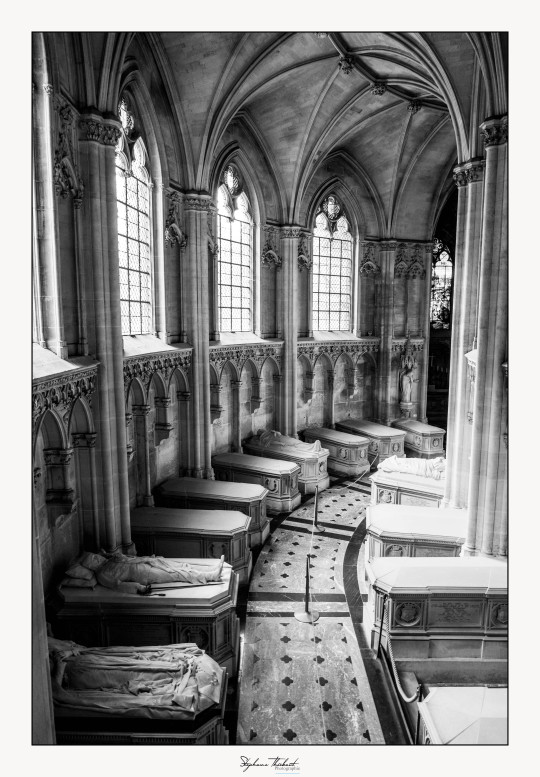
Photo originale par Steph-Photo
La Chapelle royale de Dreux où reposent les membres de la famille d'Orléans.
#original photographers#steph photo#original post#french photographer#france#insolite#noir et blanc#dreux#chapelle#church#famille royale#normandie#black and white photography#black and white#tombes#graveyard#fujifilm#monument#architecture
66 notes
·
View notes
Text
Ergo Proxy Opening: In search for the artwork's source
Ergo Proxy's Opening is a fascinating piece of artwork characterized by it's kaleidoscopic mix of scenery, images from the series and subtle references to pieces of art and literature. The whole design reminds me a bit of the style of Kyle Cooper in intro sequences like Se7en . Some are very clear while others are quite cryptic and frankly unreadable. This post will summarize a few of those references and their sources:
Holy Images

First we have the apparition of some glass panels and a statue in a column, and the image of some industrial complex. The statue have a chalice and appears to be a young man, and an eagle at his feet. Those are the attributes of Saint John the Younger. With that in mind, the search was easier... and after almost 14 hours of reading and searching, I found two of the three artworks.
Both the statue and the stained glass comes from the The Cathédrale Saints-Michel-et-Gudule at Brussels.
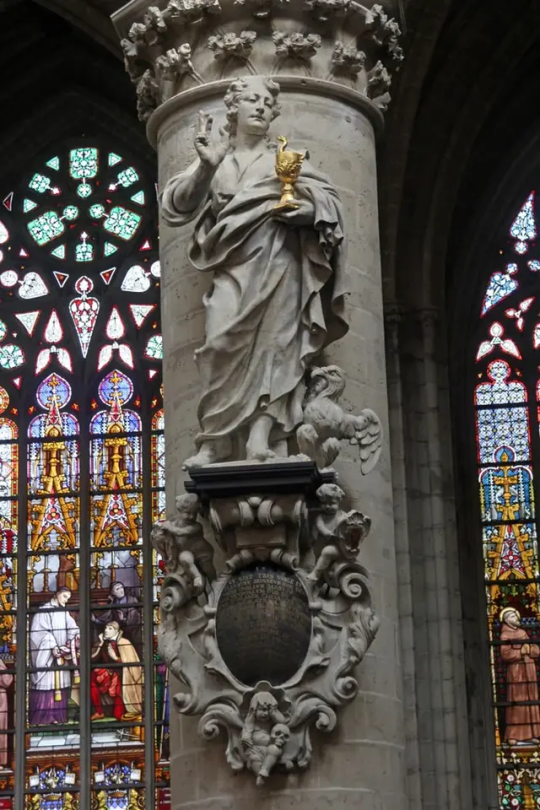
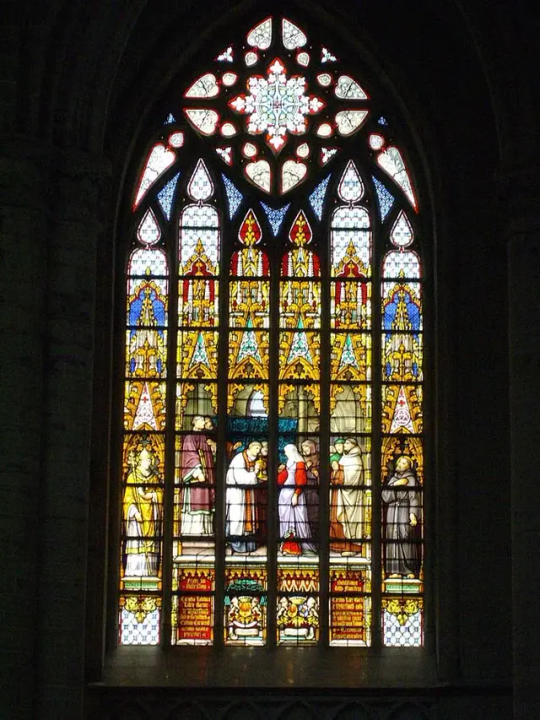
Stained Glass, probably made by Jean-Baptiste Capronnier (c. 1870):

Another decorated window appears, this time with a more modern artwork. The decorated window was designed by Alfons Mucha, c. 1930, for the reconstruction work for St. Vitas Cathedral in Prague.
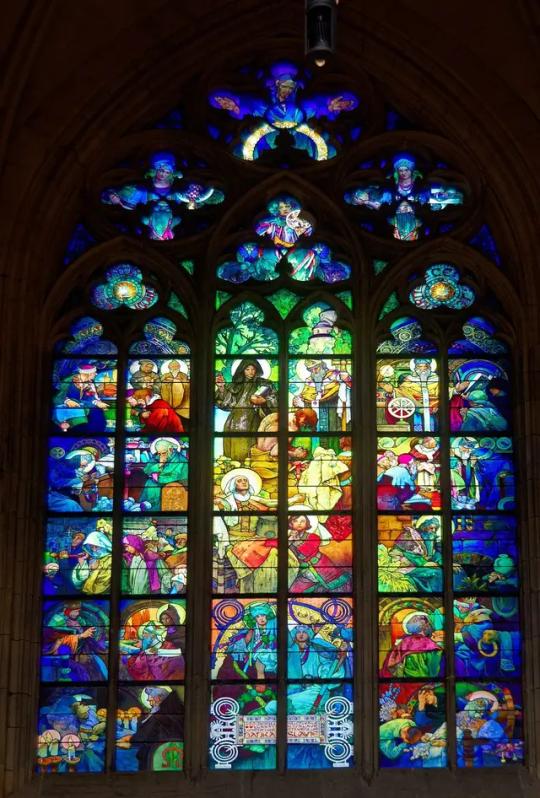
The Power of Seven and the Lapis Philosoficus
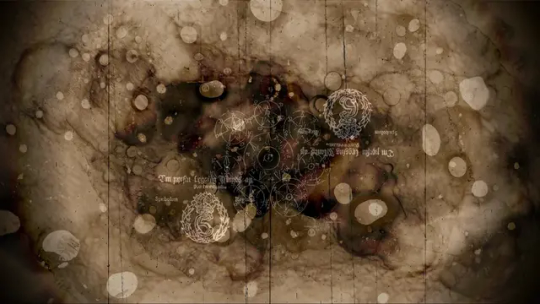
The occasional image of complex astrological or alchemical heptagrams flashes many times during the opening, being this one the most clear snap I could get. The text in the center of it reads "Ma Te Ri A Pri Ma *" that confirms the alchemical nature of the illustration.
After many attempts to find the source of the illustration i had to dive into my older alchemy notes. Suddenly I remember the works of a notorious alchemist obsessed with number seven, none other than Sir Isaac Newton. And Eureka!
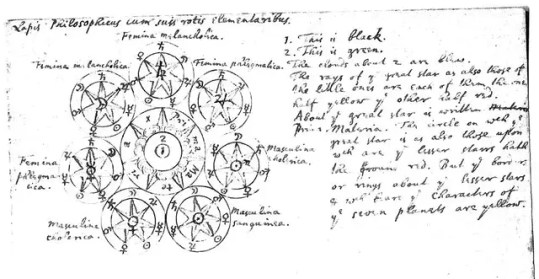
the image comes from a set of notes on the processes behind the achievement of the philosopher's stone, titled "Lapis Philosophicus cum suis rotis elementaribus" and dated to c. 1690
Landnámabók
Some of the decorations that appears on the opening comes directly from the icelandic text of settlers, a medieval Icelandic written work which describes in considerable detail the settlement (landnám) of Iceland by the Norse in the 9th and 10th centuries CE.
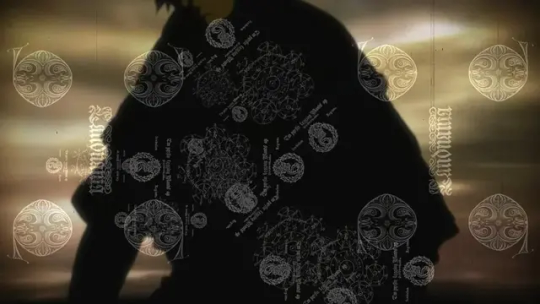

La Glorification de l'Art
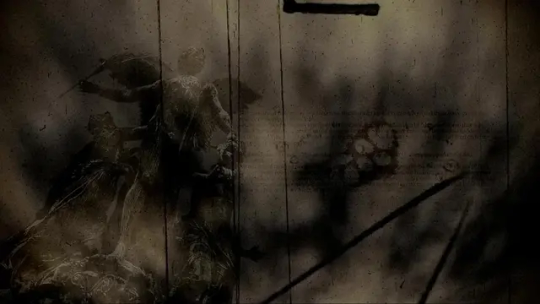
This one was relatively easy to find. It is a quite common allegorical representation.

The building housing the Royal Museum of Ancient Art in Brussels is a masterpiece designed by Alphonse Balat, the Court's favorite architect, the sculpture flanking the main entrance is the work of Paul de Vigne, and was made around 1885. La Glorification de l'Art depicts Art as a winged youth, accompanied by Glory and Fame. It also appears on the opening. Art, represented by a winged man, receives from the hand of Glory a palm and a crown; while the Fame, with trumpet and bumper, publishes her exploits.
Rhyme 247

notice the words on the right side of the screenshot: "e vero", "Non Veder" "Gran Ventura"
Michelangelo Buonarroti was an exceptionally good artist, and a passionate poet too, even when he preferred to keep most of his literary production quite obscure. One of his works for the Sagrestía Nuova at the Medici Chapel in Florence was a representation of the Night, placed over the tomb of Giuliano di Lorenzo de' Medici, Duke of Nemours. Night was singularly praised by his contemporaries, especially Giovanni Strozzi, who dedicated an epigram on 1544:
La Notte che tu vedi in sì dolci attidormire, fu da un Angelo scolpitain questo sasso e, perché dorme, ha vita:destala, se nol credi, e parleratti.
Michelangelo responded in another epigram, today known as Rhyme 247:
Caro m'è 'l sonno, e più l'esser di sasso,mentre che 'l danno e la vergogna dura;non veder, non sentir m'è gran ventura; però non mi destar, deh, parla basso
This Rhyme appears on Ergo Proxy in another occasion:
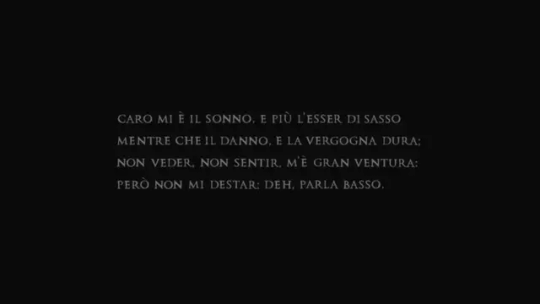
The poem as appears on the beginning of the first episode
NIGHT DAWN DAY DUSK
Donov Mayer's Collective Entourage are embodied by the four sculptures from the allegorical monument (Sagrestía Nuova) of Michellangelo. A pair of the statues were located over the sarcophagus of Giuliano de' Medici, (Day and the Night) and Lorenzo de' Medici (Dusk (or Twilight) and the Dawn) respectively. On the series, each have the name of one prominent occidental philosopher:
Lacan: as Night, Voiced by: Atsuko Tanaka (Japanese), Barbara Goodson (English)
Derrida: as Dawn, Voiced by: Yōko Sōmi (Japanese), Melodee Spevack (English)
Husserl: as Day, Voiced by: Hidekatsu Shibata (Japanese), Michael McConnohie(English)
Berkeley: as Dusk, Voiced by: Yuu Shimaka (Japanese), Doug Stone(English)

[Unknown]
Some artworks or pieces of literature used are still unknown (for me)

The industrial landscape

The cursive text

And this arabic/persian texts
Thank you so much for reading so far
11 notes
·
View notes
Photo


For Medieval craftsmen, work was an act of piety, sanctified in their own eyes as in the eyes of their God. For such labourers, end and means are one. The spiritual wholeness of faith is translated into the visual wholeness and purity of their craft.
- Roger Scruton
The Sainte-Chapelle is the finest royal chapel to be built in France and features a truly exceptional collection of stained glass windows. It was built in the mid 13th century by Louis IX, at the heart of the royal residence, the Palais de la Cité, to house the relics of the Passion of Christ. Adorned with a unique collection of fifteen glass panels and a rose window forming a veritable wall of light, the Sainte-Chapelle gem of Rayonnant Gothic architecture.
#scruton#roger scruton#quote#sainte-chapelle#church#architecture#design#gothic architecture#Louis IX#divine#spiritual#craft#medieval#beauty#aesthetics
222 notes
·
View notes
Text
Giovanni Pierluigi da Palestrina (1525-1594)
Missa Viri Galilaei [Missarum cum quatuor, quinque, & sex vocibus. Liber duodecimus (Venezia, Girolamo Scotto , 1601)]
Kyrie. Gloria. Credo. Sanctus. Agnus Dei.
_ Palestrina – Missa Viri Galilaei Ensemble Organum, Marcel Pérès. Ensemble Vocal Europeén de la Chapelle Royale: Philippe Herreweghe. (1992, Harmonia Mundi – HMC 901388)
25 notes
·
View notes
Note
Is the story about anne boleyn's ladies personally burying her and binding her legs to prevent her corpse being desecrated true??
✨ terfs/zionists fuck off ✨
her ladies would have been obligated to transport her remains to the chapel or at peter ad vincula. the claim that her ladies distrusted men to handle her comes from lancelot de carles: “the head and body were taken up by the ladies, whom you would have thought bereft of their souls, so languid and weak were they with anguish, but, fearing that their mistress might be handled unworthily by inhuman men, they forced themselves to do this duty”. however, i think certain details about anne’s execution are suspect — that is not to say they’re all untrue, but i don’t think they should be uncritically accepted as unbiased and wholly accurate. in this instance, lancelot de carles was an eyewitness, but likely not privy to the reasoning for the ladies tending to her remains… did they tell him/witnesses they did not trust men to handle anne, a la the scene in wolf hall? we can directly compare anne’s execution to katherine howard’s, and in the detail of ladies having the responsibility of handling the body, both executions are identical: “her [katherine’s] body was then covered with a black cloak and her ladies took it away” (chapuys). it seems to me that the handling of the executed queen’s body was considered a job for the women serving her, rather than a distinct act of loyalty/compassion such as de carles suggests.
moreover, i think a lot has been read into a very small detail, and the way it has been sensationalised is… well, it’s very tiktok.
no, there is no contemporary basis for the claim that they bound anne’s legs (what would the need be? she was immediately interred, and i doubt graverobbing and/or necrophilia unto the remains of an anointed queen was particularly feasible inside a royal fortress as fortified as the tower of london…) but i have seen it referred to in the same posts/videos that associate the treatment of anne’s body by anne’s ladies with the anecdote of wives of samurai tying their legs together prior to committing suicide in japan, which i think is where this specific detail comes from.
simply put: japanese history is not english history. there are unique nuances to the act of female seppuku/jigai. the detail of binding legs seems to have as much to do with a presentation of honour as it does a security measure: "women often tied together their knees so that their bodies would be found in a decorous position, and their honor would be preserved". this is not to undermine the threat of necrophilia to female cadavers, but it's hugely reductive to simplify ritual suicides and the culture/history surrounding that as a point of comparison, and i’m uncomfortable with the desire to sensationalise and sexualise anne boleyn’s execution, frankly.
likewise:

it’s not true. there’s no evidence that katherine’s body was deliberately destroyed. we don’t need to invent historical misogyny and violence against women. we have real examples throughout history and those histories deserve acknowledgement. for example: people frequently reference the violations of katherine parr’s body in these conversations but it is anne — whose body never suffered any violations — who gets centred in them. consider, instead, this article about katherine parr’s afterlife.
9 notes
·
View notes
Text

Montolieu est l’étape idéale pour les amoureux du livre
Montolieu (Aude) constitue une agréable escapade à quelques kilomètres de Carcassonne. Ce « Village du Livre & des Arts » rassemble 17 librairies et a séduit de nombreux écrivains par son charme. L’occasion d’une belle balade littéraire dans les rues du bourg.
C'est l'un des 8 villages du livre recensés en France. On y trouve des libraires de livres anciens et d'occasion mais aussi des professionnels des arts et des métiers du livre : relieurs, doreurs, graveurs, calligraphes, enlumineurs, fabricants de papier, imprimeries artisanales, éditeurs.
Dans les 17 librairies du village, on trouve principalement des livres d'occasion, avec du vécu… une histoire. Certaines sont spécialisées en livres jeunesses ou encore en littérature anglaise : il y en a pour tous les goûts.

Après avoir visité Carcassonne et sa fameuse Cité médiévale, une étape par Montolieu (Aude), charmante commune située à une quinzaine de kilomètres, s’impose. Il s’agit d’un « Village du Livre & des Arts », autrement dit un bourg rural où sont installés des librairies et des commerces d’artisanat autour du livre.
Riche d’une longue histoire, puisque occupé depuis la Préhistoire, Montolieu est devenu un village du livre en 1990, à l’initiative de Michel Braibant, relieur belge installé à Carcassonne, explique l’office du tourisme du Grand Carcassonne. Son rapport avec les écrivains est toutefois plus ancien encore : le village en a inspiré beaucoup, comme l’autrice Anna Gavalda, qui a vécu à Montolieu quelques années.
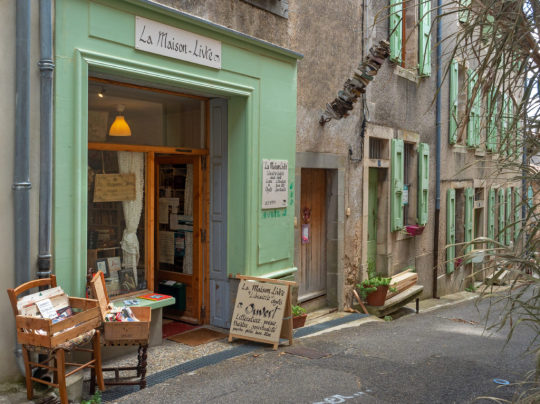
Au total, aujourd’hui, cette commune de 800 habitants compte 17 librairies de livres anciens, neufs ou d’occasion. « Certaines librairies ont justement des spécialités (BD, jeunesse, art, revues, journaux anciens…) », détaille l’office du tourisme. Les visiteurs peuvent aussi arpenter les 15 galeries ou ateliers d’art du village. Le bourg dispose par ailleurs d’un Musée des Arts & Métiers du Livre, où il est notamment possible de s’initier aux arts graphiques.

Mais plus généralement, ce bourg pittoresque est l’occasion d’une agréable balade. Au détour de ses ruelles fleuries et de ses maisons anciennes, il est possible de découvrir l’église Saint-André, un édifice du XIVe siècle classé aux monuments historiques, l’ancienne manufacture royale de draps, ou encore la chapelle Saint-Roch, qui offre un magnifique panorama sur les environs.
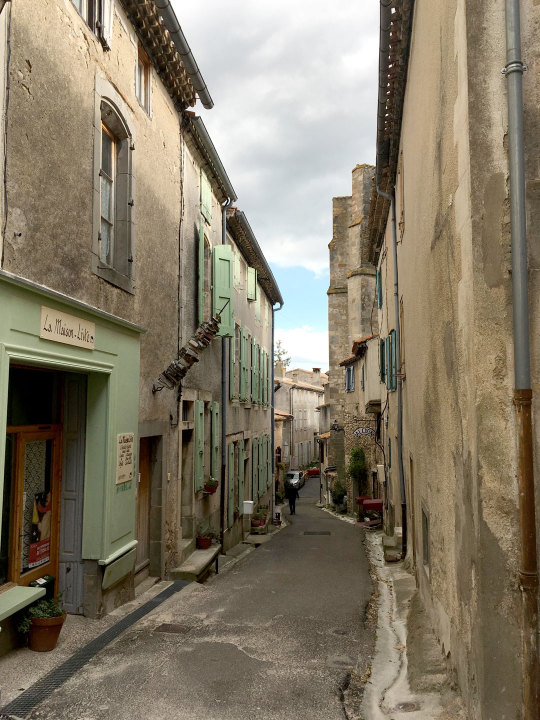
Situé sur les contreforts de la Montagne noire, au beau milieu des vignes, Montolieu ouvre sur de nombreux itinéraires de randonnée dans les gorges de l’Alzeau et de la Dure, avec ses ponts et ses moulins. « Oliviers, cyprès, variétés de cactus et arbustes fleuris mettent sublimement en beauté le paysage », assure l’office de tourisme.
Daily inspiration. Discover more photos at Just for Books…?
8 notes
·
View notes
Text
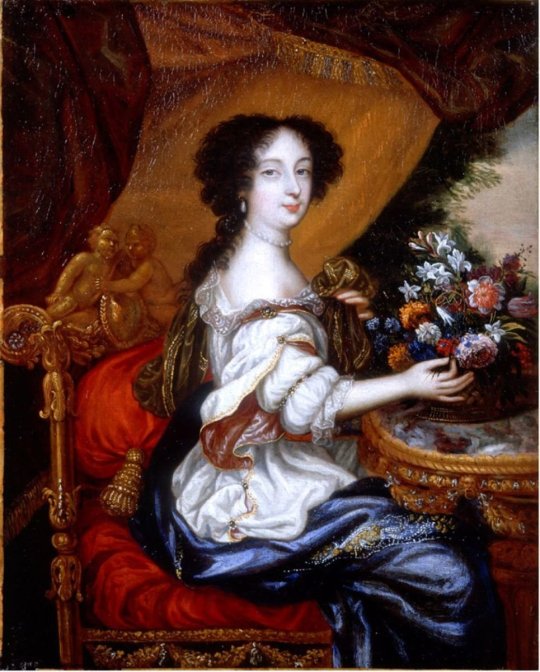

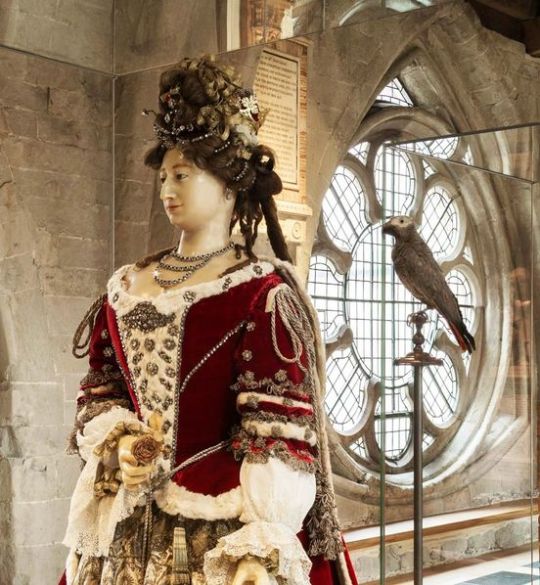

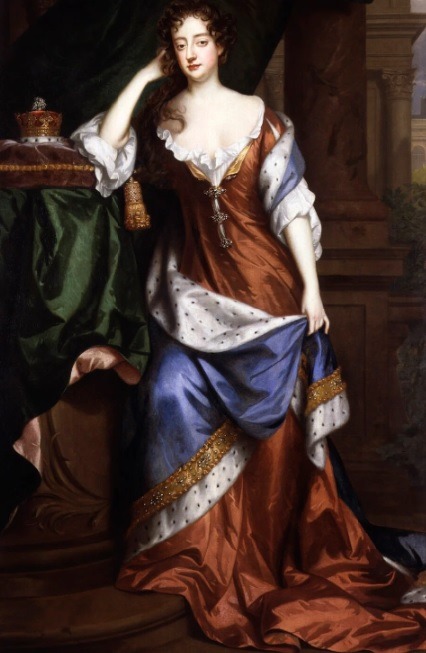
On 8th July 1647 Frances Stuart, known as “La Belle Stuart” was born.
Frances was the daughter of Walter Stewart, or Stuart, a physician in the court of Queen Henrietta Maria, wife of Charles I who was in exile in France.
When the Stuarts returned to the throne with the Restoration she went with them. In 1662, she became a Maid of Honour to Charles II's bride, the Infanta of Portugal, Catherine, and then a Lady in Waiting to the new Queen.
Reportedly, Charles became infatuated with the girl, but she resisted his advances. In 1664, after England won several naval victories against the Dutch, the king had medals struck depicting the figure of Britannia, he chose Frances for the model. The King was so besotted with her that he considered divorcing Catherine to marry her. Samuel Pepys, the diarist, recorded that she was the greatest beauty he had ever seen.
Considered a great beauty, she had numerous suitors, eventually she eloped with another Charles Stuart, a fourth cousin of the king and the 4th Duke of Richmond and 6th Duke of Lennox in March 1667. She fell out of favour at court for marrying without royal consent.
About 1669 she became seriously ill with smallpox and the king reportedly rushed to her bedside and forgave her for marrying. Upon her recovery, she was appointed Lady of the Bedchamber for the Queen. The king appointed the duke ambassador to Denmark, but Frances stayed at home, managing the estate and business affairs.
The duke died in December 1672 and as he had no heir his estates reverted to the Crown. Charles II granted Frances a 1000 pound pension per annum for life. In 1702 Frances arranged to purchase the estate of Lethington. She died that same year leaving her estate to her nephew Lord Blantyre who renamed Lethington Lennoxlove in her honour.
Pics include two paintings of “La Belle Stuart” and a remarkable wax effigy she ordered that had made of herself dressed in her coronet, robes and shoes worn at Queen Anne's coronation,. She had it set up in Henry VII's chapel near the grave of Ludovic Stuart, cousin of James I, in Westminster Abbey, the effigy survives and beside it you will see an African Grey parrot, which was her “companion” for some 40 years, the parrot died a few days after her.
As seen in the last pic, very few mounted bird specimens survive from this period but x-rays show that the entire skeleton of the bird is intact including its skull. This was a very primitive technique but the parrot probably survived because it was kept in a showcase. It is perhaps the oldest stuffed bird in existence.
9 notes
·
View notes
Note
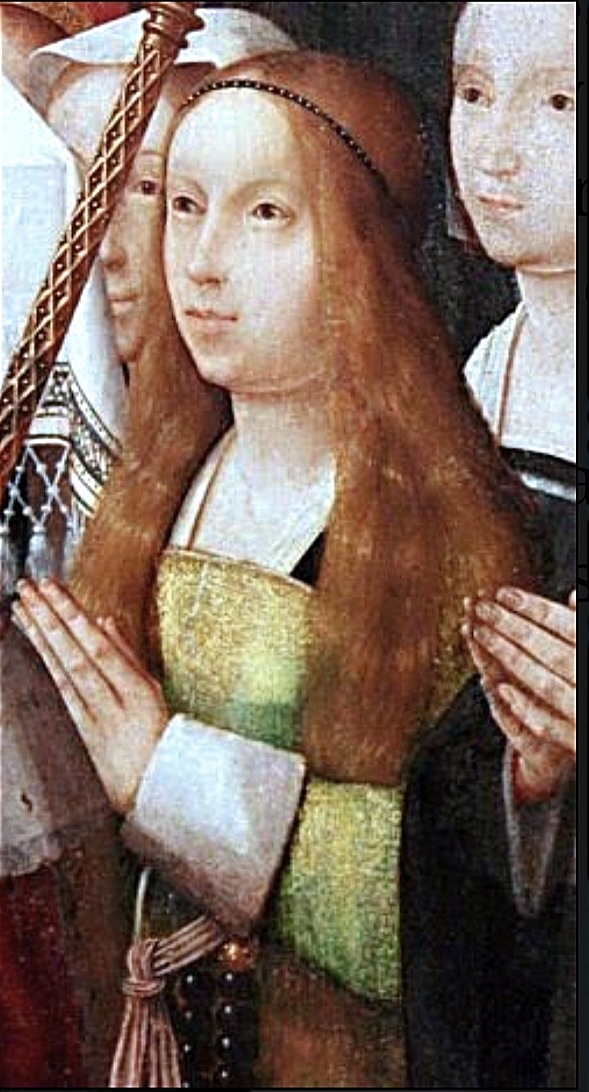
This is an imagen of María of Aragón, Queen of Portugal, from the Tríptico de Nuestra Señora de la Misericordia, Jan Provost, c. 1515.
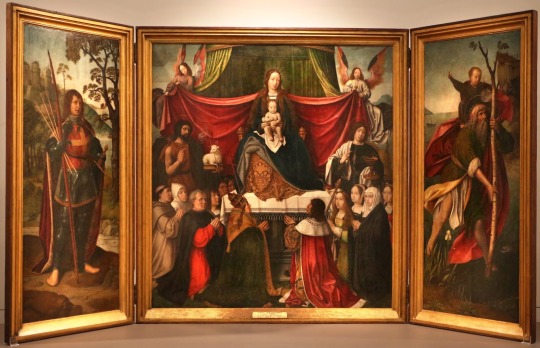
I presume you wish to hear my thoughts about this painting, since no question was written.
Despite Jan Provoost never provenly leaving Low Countries, surprisingly not so small amount of his art are on Iberian peninsula.
Some of them provenly there since not long after their making, presumably comissioned directly. Not really sure how that comission process exactly worked.
Probably the best quality photos I could find of it are from this webpage.
Which also sheds bit of light about its history.
This painting is believed to be comissioned by Nuno Fernandes Cardoso and his wife Leonor Dias in 1511 when they had ordered construction of Chapel called la Capilla de San Juan de Letrán including the triptych for its altar. Thus it is presumed the painting was comissioned between years 1512-1515, not long after.
I have some issues regarding the royals within.
Number 1 all photos ignore the fifth presumed member of royal family-The girl in red dress on right.


(and fact two more figures are partially hiden behind the altar.)
It is believed by some that from left to right these are Manuel I, Maria of Aragon-his wife, Isabella of Portugal-his eldest daughter, Eleanor of Viseu(Dowager Queen of Portugal-wife of his predecessor) and Beatrice of Portugal-his younger daughter.
Not sure about costumes of everybody, but presumed daughters are dressed in Netherlandish outfits.
While i cannot rule out he was sent some sketches, the faces of these women are consistent with generic figures from other paintings by same artist. With designs which he was reusing.
Thus even if identification as royals is correct, it is not likely for it to be true likeness. (However in some cases, the artists were chosen because their already existing work reminded people of their loved ones. )
But the question on my mind seeing this triptych is-Where the heck are his sons? The painting is believed to be made in betwen 1512-1515.
By this point Manuel and Maria had 3 daughters and 5 boys. People were sexist back then, so idea King Manuel got depicted with wifey and daughters only is cute...but unrealistic.

While we have 7 male figures on left, one is pope(on right), one is old man, then there is monk(infante Henry was cardinal), and 4 more figures, not all of them even showing full face. They are not at front, but at back. Like is it symbolical...or were those boys not important?
Secondly, why would every royal except Manuel be depicted in clothes better fitted for somebody of lesser status?
Another depiction of the same royal family by Netherlandish artist Colijn de Coter is called Fons Vitae, and there despite outfits being netherlandish at least they were what we would expect from depiction of royalty.

Ermine, cloth of gold, crimson also popular with plenty of royals. But here only Manuel wears such suptuous robes.
(the other male with fur-that is not ermine, they specifically sewn those so that the tails appeared regularly.)
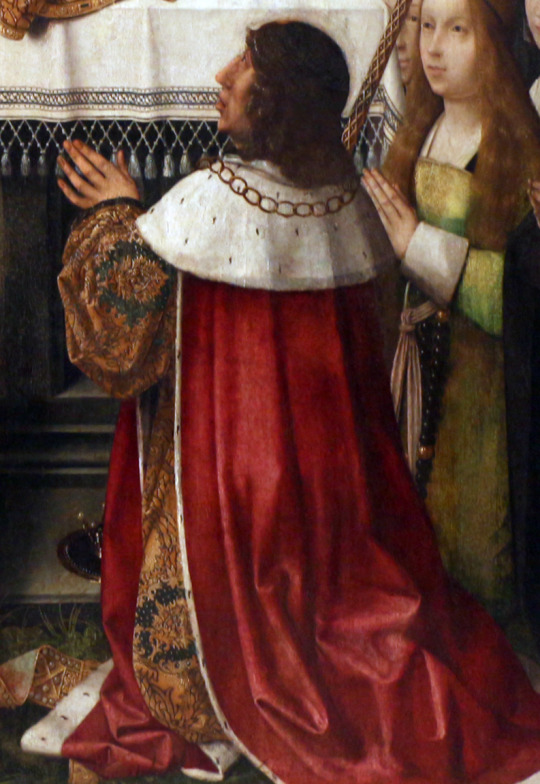
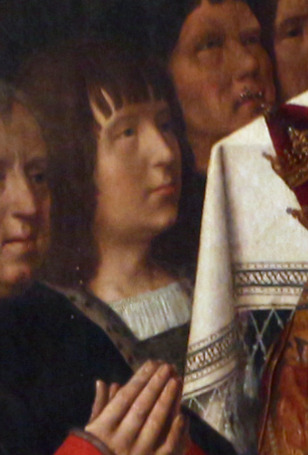
Thus i fear, it might be the case that Manuel is the sole royal depicted.
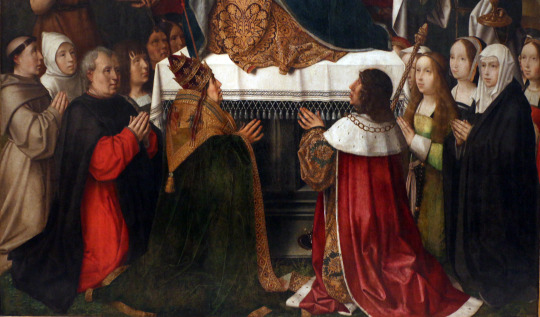
And that we have pope and king in central positions beneath Virgin Mary and people on sides will be the patrons and the family.
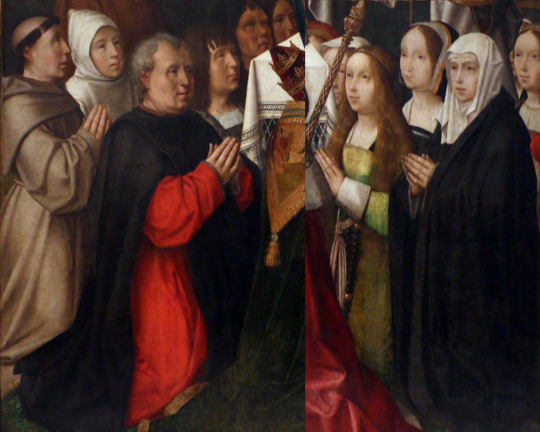
Possibly people who had the painting comissioned. Which would mean the grey-haired man in red and black is ment to represent Nuno Fernandes Cardoso(with his male relatives behind him).
And his wife Leonor Dias, is represented by either the woman in green or the woman in black with white headwear-which is also positioned probably the most at front(with the female relatives behind her.)
Thus in my opinion it could be the case of wrong identification, based upon proximity to the figure of the king and the fact the woman has golden hair (or at least i think she might have) and ribbon on upper part of forehead is bit similiar to how cofia the tranzado was worn with ribbon across forehead.
But even if i was wrong about this female not being ment to represent Maria, the face matches rest of generic saints by this artist. (for example the one on left)

Sorry. This is pretty face, but likely not Maria's.
12 notes
·
View notes